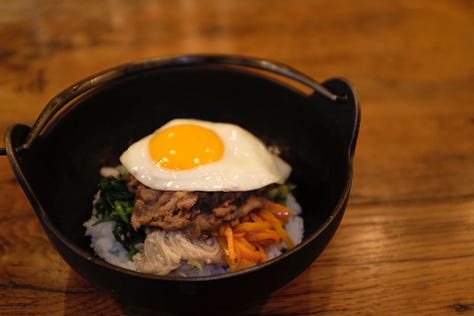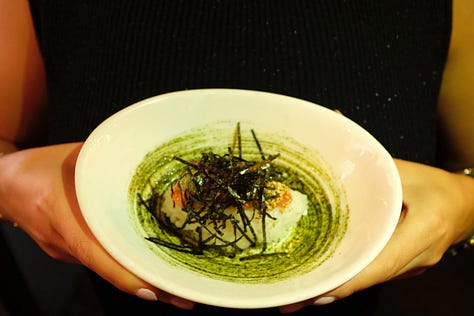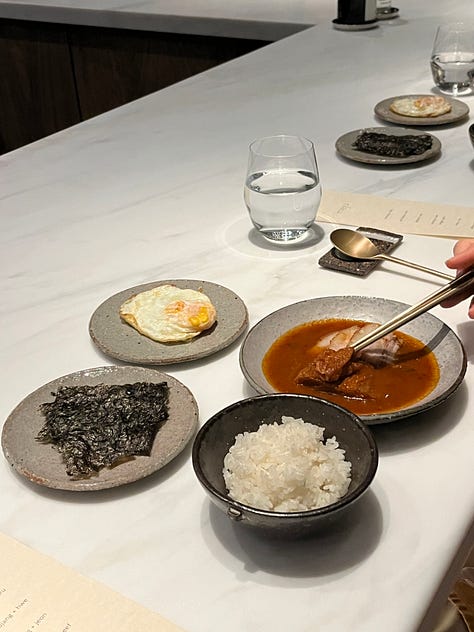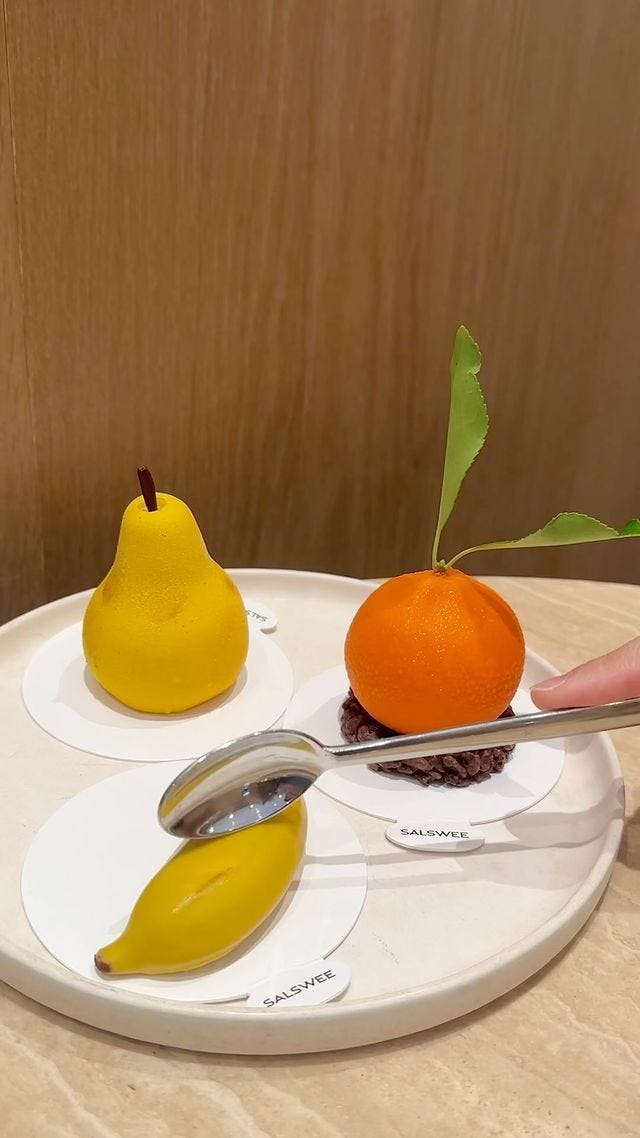The irony of me sitting down to write this is that since first drafting this note in June I have gone to Mexico City, returned from Mexico City, befriended my apartment toilet bowl and, for the first time in a while, sighed an unhappy sigh at a New York bagel. I can’t stand the sight of food. My grave mistake was not listening to
. I ended my trip at Contramar, no strawberry cake, a short, sober dinner on a stormy Saturday evening. Perhaps, though, this is the best time for me to be articulating this New York food interlude — to be most critical, skeptical with you all (as if I were already not).A lot has happened in hospitality. In early June New York State passed S.9365/A.10215, which plans:
To require online third party food service reservation apps obtain
consent from a food service establishment prior to such app marketing or
making a seating reservation at such food service establishment.We may all finally be one step closer to a 4 Charles reservation.
What I’ll miss the most… The joy of a creatively secured reservation. New foodies would be surprised to learn that despite also the joy of a hard fought reservation (setting an alarm on your phone to check Resy at 9:58am before the reservations drop) I’ve learned it’s sometimes much simpler than that.
They say creativity often lies in simplicity:

And frankly a stock market-esque restaurant reservations website showing live stats (marketplace volume, most recent listings sold, best converting venues, top “sellers”) is pretty damn creative.

So how do I really feel about an impending Appointment Trader ban? And why are news outlets just now discovering this site?
Today’s meal: several food adventures in April and May, a talk at the Harvard Club, fake fruit, and “jang”.
Tatiana v. Gage & Tollner
Sometime in April I was fortunate to eat at two restaurant institutions: Tatiana, a buzzy Afro-Caribbean restaurant in Lincoln Center ranked by Pete Wells of NYT as the NUMBER ONE restaurant in New York in 2023 and 2024, and Gage & Tollner, a deeply historic oyster and chop house c. 1879 in Downtown Brooklyn which had closed in 2004 and then reopened in 2021 (another interesting read).
I ordered hefty meat dishes at both places. “Short Rib Pastrami Suya with Caraway Coco Bread and Melted Red Cabbage” at Tatiana and a “NY strip” at Gage & Tollner to be exact. Both were good (critical I tell you).1
I kept thinking, however, about the great success of the two restaurants: one in early accolades, the other in longevity. Tatiana: at the corner of David Geffen Hall overlooking old-school ballet performances, operas, it’s unexpectedly neon purple cloud lights reminiscent of the James Beard Award-winning, Forbes 30U30-nominated actor/ chef’s youth. Chef Kwame Onwuachi is just 34 after all. Gage & Tollner: heralded by a 1930 guidebook as “Brooklyn’s main contribution to civilization” where waiters wore tuxedo jackets and white aprons and where shoppers dined after visiting high-end department stores on Fulton Street in the 20th century. It’s Victorian interior was later fully restored (including what resembles their gas lamps which the most senior staff lit as daily tradition) thanks to latter establishments putting up drywall interiors (thank you TGI Fridays and Arby’s).
What would
say? If not necessarily felt from the food, how had these successes found product-market fit, if so?🕯️This is your intermission time to read The Unifying Theory of Restaurants.⏱️⏱️
Surely a quintessentially high-demand, low-supply club like Tatiana would name their dish a “Short Rib Pastrami Suya with Caraway Coco Bread and Melted Red Cabbage.” Their high Guest Potential Value (customer value from one visit) is derived by its own exclusivity, through hallowed reviews matching word-of-mouth hype and, these days, TikTok “obsessions” (2.9M views to be exact). How, then, does a club maintain its relevance (does scarcity promise relevance?) and at what point does the business of saying “no” make diners give up trying as well?
Gage & Tollner, with its History (once a popular spot for men “asking a girl to marry them”), landmarked location, higher price point (comparable to Keen’s, slightly cheaper than Peter Luger), memorabilia sold on eBay, and restaurant merch, SHOUTS club. I’ve been told they don’t do take out. And yet, Gage & Tollner is still quite accessible (most likely given sqft): You can always find a reservation the day before. It just might not be at the time you want (i.e. 6-8PM). For what it’s worth, my visit to Gage & Tollner made me less sure of its place in the world of diners and clubs, observing larger parties in friendly conversation with waiters as though they were regulars. Then again, as with many steakhouses, aren’t we made to feel like regulars? The abbreviation of the “NY strip” because we get it. We’re New Yorkers. Maybe then we should be asking what makes a New Yorker?
Alison Roman at the Harvard Club
, restaurant chef turned food writer, visited the Harvard Club in May. And I left grinning, thinking about the art of hosting and my own food origin story. My favorite snippets below:On having people over:
“When you have fewer resources you become creative and scrappy. Put the ice in the tub”
“It’s so much better to have one centerpiece focal point. Pair back and make one moment. You hear “ham party” and all you think of is ham. I want to underpromise and overdeliver.”
“Just be happy to be there… and remember everyone is feeling the same, everyone was drunk. We have a tendency to center ourselves when we’re hosting. The better time you have the better time others will have.”
On word of mouth: “The only reason my recipes are successful is because people cook the recipes and talk about it. That’s more powerful than any kind of marketing or SEO.”
Roman’s “Goodbye Meatballs” recipe is about getting broken up with and making meatballs. Someone recently asked her if the guy ever reached out again. He did not.
On buying an old pizzeria upstate and opening a grocery store in its place: “I love old buildings and old things that feel they can only be there. Things are easily replicated but it’s very hard to replace a soul of a place. A physical space has an energy you can’t recreate.”
Food origin story? Roman’s still figuring it out. It’s surely not one succinct romantic food story. Her dad was a “classified eater ‘go here for the best chili dog, best taco’. Food was important to him culturally…” Her parents were divorced. Her mom notoriously a bad cook but her mom’s dad was the biggest cook. He raised his own rabbits and grew his own tomatoes.”
Salswee and other fake fruits
I walk by Salswee, a minimalist bakery in Flatiron, every day on my way home from work. It’s rather unassuming, white walled like its neighbored retail stores, minus door handle baguettes, a precursor to what’s in store. I walked in once to see what kinds of things they sold. “Ugh, no more fruits.” A girl had walked in right after me and immediately walked back out.
A quick Instagram scroll had me realizing what she meant by fruit:
Lo and behold, these treats are far from new. In 2017, Vogue documented the stardom of French pastry chef Cedric Grolet and his pastries that look exactly like real fruit. And we’ve seen others over the years: Le Bernadin’s apple, Jungsik’s banana, Lysee’s corn, Konban’s corn cob (notably ice cream not cream), Empellon’s avocado (I like the “taco” ice cream better).
As Grolet shared in the 2017 article, fruit as dessert and as snack often evokes nostalgic adolescence. For him, it was growing up in the countryside where his mother would feed him fruit as midafternoon snack. For me, it was running to the fridge after dinner in search of fruit, cut, peeled, shared amongst my family of 4 at the dinner table. Connie Wang’s “Love In The Shape Of Cut Fruit” beautifully articulates a more bittersweet nostalgia. One could argue this is hospitality’s delayed reaction to the 2023 year of the girl (or the anguish of teen girls). This post from
sums up the modern girlhood trend well.Our global health scare of 2019 drastically shifted food culture and consumer priorities (and continues to) with emphasis on #gut-healthy, #better-for-you foods and obesity management more recently with GLP-1s, and individuals yearning for in-person interaction and experiences (does a 3-hour wait for Eleven Madison Park pastries count?). In NYC’s era of hype bakeries, a meticulously designed pastry is a little luxury. A meticulously designed pastry resembling a nutritious piece of fruit? Expect a line.
In a parallel retail context (drawing closer together as more hype bakeries pop up/ drop),
sums up these thoughts far more succinctly: “I will add that the fetishization of fresh produce feels uniquely American”. And in the case for food, uniquely resilient.“jang” from Meju
The summer after high school I served as a hostess at Chef Hooni Kim’s Hanjan, Flatiron’s original Korean restaurant inspired by homestyle cooking and old travelers’ taverns. I grew up in a household of Alison Roman-characterized “classified eaters” so the experience was extra special.





I didn’t interact as much with Hooni as he was in Korea for the summer learning from jang-makers at fermentation farms. In the quiet revolution of Korean culture in American life, Americans know kimchi. But if you’ve ever tried Korean food you’ve likely also tasted one of the three foundational jangs: doenjang (soybean paste, most commonly used to make doenjang jjigae), ganjang (soy sauce), and gochujang (chili paste, think bibimbap, tteokbokki). Gochujang is not to be mistaken with ssamjang, a dark orange mix of doenjang, gochujang, garlic, sesame oil, among other ingredients typically served with grilled pork and lettuce.
Then a pandemic-shuttered Hanjan turned into a dark kitchen of sorts selling ‘Heat & Serve’ meal kits to New York residents then in August 2022 into Little Banchan Shop, a Korean specialty foods store in Long Island City (LIC), a neighborhood Hooni has called home for 11 years. By some stroke of too-much-space-outside-of-the-city fate, Little Banchan Shop became the entrance to Meju.2
For my dad’s birthday, my family ventured to LIC. Ironically, the eight-seater, six-course restaurant seemed fit more for Manhattan, as though in a friend’s luxurious apartment gathered around a kitchen counter.
You’re probably wondering in what universe a four-money-sign tasting menu restaurant feels like a home. Meju is a Michelin-starred restaurant after all (awarded less than a year after opening in January 2023). But in a city where Korean chefs have quickly taken over the fine dining scene, Chef Hooni’s “flourishes” pull not from French cuisine but rather from the stories of Korean ritual and community. He situates us in this modern Korean home surrounded by hanok doors, conjuring times when ancient Korean neighborhoods gathered to prepare batches of fermented foods, recipes on Korean flavor passed down through moms as tradition. In fact, Hooni reminds us that knowledge is power (and tasty). After all, they say the best lessons are learned at the family table.
And boy did I learn a lot that night (the very-beginner cook and good student that I am):
I learned Korean cuisine is far more
#gut-healthythan one now-very-commercial side dish (kimchi).When making doenjang in onggi jars the paste rises to the top and ganjang sinks to the bottom. Two-in-one!
I tried the same vintage of Hooni’s ddoenjang (2015) as Grubhub’s Meju reviewer and writer E. Alex Jung.
I learned about the medicinal practice of some jang-makers as detailed by Hooni on his mentor. The two engage in debate on taste, Hooni seeking a momentary moment of pleasure. “He forgets I’m a chef.”
And so, I also learned to taste the flavor of 129-year-old soy sauce beyond its saltiness. Hooni continues, “Search for the flavor and it’ll reward you.”
I learned Meju’s seven-course menu is described rather vaguely for a reason (photo below): leaving space for the farmers to create the menu, Korean moms who’ve passed down recipes and tradition to their children.
Last but not least, to have a good meal is to enjoy a night of good sleep.
Two-thirds of the way through the course, there was a 10-minute intermission where we were invited to walk around and explore Little Banchan Shop (now this is how you extract Guest Potential Value). The gift shop to my history lesson in flavor didn’t sell truffles or caviar. Just good, homestyle Korean food, from Hooni’s home to mine.
For all my visual learners:









Here’s hoping @laureniseating soon.
Love, Lauren







The content this gal (me!!!!) has been waiting for